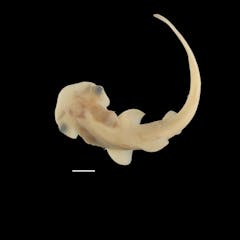
Articles on Sharks
Displaying 1 - 20 of 212 articles

Young sharks are gathering at a popular beach. Here’s why we should skip our fear response and go for wonder – and protection

Egg cases of sharks and rays can be found washed up on the shore. Citizen science data helps scientists understand the life cycles of these marine animals and how to best conserve them.

A new report has found the marine reserve covering the Heard and McDonald islands must urgently be expanded.

Because hammerhead sharks give birth to live young, studying their embryonic development is much more complicated than harvesting some eggs and watching them develop in real time.

Across the world, fewer than 280 megamouth sharks have ever been seen. The first sighting in east Africa has just come to light.

Trophy fishing is a big threat to some of the most threatened species of fish, but there are ways to adapt the sport with marine conservation in mind.

‘Jaws,’ published in 1974, terrified the public of sharks, but it also brought shark research into the scientific mainstream.

A new initiative is pinpointing areas in the world’s oceans that are key habitats for sharks and their relatives, so that governments can consider protecting these areas.

After scientists’ GPS tracking tag was violently removed from one shark’s dorsal fin, they were in for a surprise: The wound didn’t just heal, but the missing tissue grew back.

Peter Benchley’s classic 1974 ‘man versus beast’ blockbuster novel doubled as a scathing critique of 1970s America. Spielberg’s film made its characters likeable – and its tone into a ‘grand adventure’.

When ships sink, they add artificial structures to the seafloor that can quickly become diverse, ecologically important underwater communities.

Increased interest in recreational fishing with drones has led to concern about its environmental and social impact.

Scientists found PFAS hot spots in Miami’s Biscayne Bay where the chemicals are entering coastal waters and reaching the ocean. Water samples point to some specific sources.

Archaeologists have discovered two 7,000-year-old tiger shark teeth that were once part of ritual or fighting blades on the Indonesian island of Sulawesi.

Scalloped hammerheads pose no risk to us – but we pose enormous risk to them. Our discovery of a large new aggregation gives us an opportunity to protect these animals.

South Africa’s white shark population is not in decline but migrating to survive.

Megalodons are having a cultural moment. What do we know about them? And might further scientific discoveries reveal more about the true shape and size of these creatures?

A paleobiologist on why he appreciates the franchise despite its inaccuracies.

Open ocean sharks are globally threatened with extinction. Knowing where they are helps us protect them. Here, new research into silky sharks reveals priorities for conservation.

Some baby sharks eat their unborn siblings in utero, while others spend 100 years in childhood. Sink your teeth into the weird world of these juvenile wonders of the deep.
